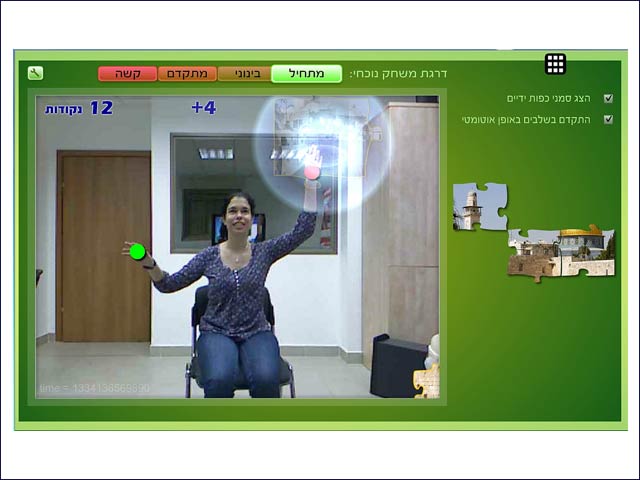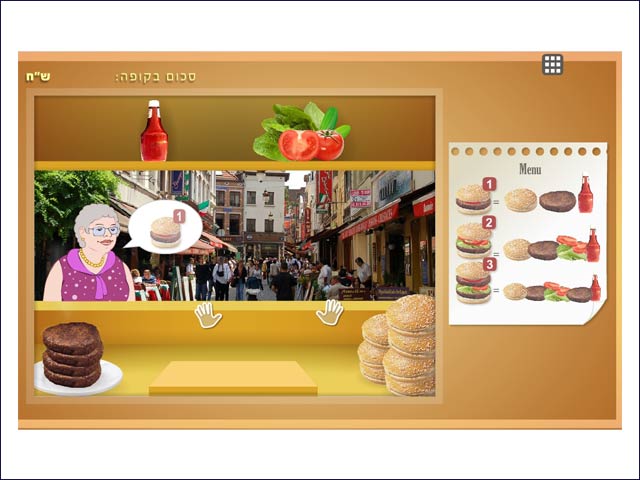By Rivka Borochov
Video games often get a bad rap for being too violent or time-consuming. While some kids may become couch potatoes from overuse, Israeli occupational therapists are inventing new methods and applications for motion-control games that help squeaky joints and muscles move again.
Israeli therapists are prescribing gesture recognition games from Kinect (a software technology that enables movement, voice and gesture recognition) in addition to traditional movement therapy for patients after a stroke or children with cerebral palsy. They have also developed a new app tailor-made for the Kinect system so that people can do their therapy at home in an affordable manner.
Clinical findings suggest that playing video games may give some people a better chance to reach their post-stroke potential.

Gertner Tele-Motion Rehabilitation System in action In one study, occupational therapist Debbie Rand from Tel Aviv University found that stroke survivors moved their arms twice as much in goal-directed movements. Working in groups, patients exhibited better mobility overall after three months of “video game therapy” compared to a group of people who used a conventional approach.
Rand has worked for more than a decade on the effects of activities such as virtual shopping and interactive video games on motivating people with injuries or disabilities to regain the ability to move. Rand presented her results at several conferences, including the International Conference on Virtual Rehabilitation held in Valencia, Spain.
During the sessions she administered, stroke patients played gesture-recognition video games using Xbox Kinect, Sony PlayStation or Nintendo Wii consoles. Each group played two sessions a week with their occupational therapists over three months.
Getting the sweat out
The study compared two groups, both comprised of 20 people who had suffered a stroke from one to seven years before the therapy started. One group played video games, and the other group had a program of traditional therapy.
Both groups improved movement functions measured by grip strength and gait speed, but the video game group notably continued to improve grip strength three months after the sessions, while those in the control group did not.
In surveys, 92% of those in the video games group said that they enjoyed their therapy, compared to 72% in the traditional therapy group.
Those in the video games group gave feedback such as, "It was lots of fun," "It stimulated all of my senses" and "I finished the sessions wet from sweat, which proves that I really worked hard," reporting excitement levels that indicate they would continue playing the games for therapy.
One of the devastating after-effects of a stroke is the inability to accomplish daily chores: dressing oneself, bathing and cooking, to name a few. The closer therapists can get patients to the way they were pre-stroke, the better their quality of life will be.
Therapy is crucial to regaining lost motor and cognitive abilities. And since gaming consoles are relatively inexpensive and widely available, they may become a widespread mode of movement therapy for stroke victims in the future.
Rand’s results are no surprise to Tamar Weiss, her former master’s and PhD adviser. Weiss, from the University of Haifa, is considered to be the first in the world to pioneer the use of video games as occupational therapy, back in 1998 while on a sabbatical visit to the University of Toronto.
She then worked with Rachel Kizony and Noomi Katz in the early 2000s and with Debbie Rand in the mid-2000s to develop treatments tailored for stroke patients. The notion of using video games as therapy has since “avalanched,” says Weiss.
A nation that fosters high-tech healthcare
Weiss and colleagues at the Gertner Institute (located at the Sheba Medical Center) are also developing new tools for using virtual reality and gesture recognition to aid the disabled. They devised a series of games especially for people who have had a stroke. It could also work well in children with cerebral palsy, she says.

A Gertner Tele-Motion game The game is part of the
Gertner ReAbility Online System. The Gertner Institute developed two systems for treating motion and speech impairments. The systems received the approval of the Israeli Ministry of Health, and service was launched in September 2013. The systems, which increase patient access to rehabilitation care without the necessity of going physically to a healthcare facility, have focused on patients who have had a stroke or traumatic brain injury.
Since the service was launched, it has provided more than10,000 online sessions to more than 220 home patients. The service is currently deployed at Sheba Medical Center, Reut Medical Center, and Sourasky Ichilov Medical Center. The patient “plays the game” in front of a home computer, which is remotely monitored by an occupational therapist at the medical center. The OT gives the patient real-time feedback and can work with more than one patient at a time. The system can also provide feedback directly to the patient, enabling self-practice to be done at home independently. The system uses a Kinect camera installed on the home computer.
Kinect, which uses Israeli technology developed at PrimeSense (a pioneer in 3D sensor technology that was acquired by Microsoft in November 2013), is the only gesture-recognition system to date that has an open-source platform that allows developers to create novel apps for it, says Weiss.
While clocking results on standard video games is good, Weiss notes, “The thing that will really make a big difference in healthcare is not off-the-shelf technologies for use at home under supervision. These games never were and likely never will be well-adapted for people with disabilities.”
This is one reason why she has stepped away from using what’s on the market in order to help create something new.
The nexus of entrepreneurialism, high-tech and occupational therapy is not that uncommon in Israel. Weiss, Kizony, Rand and myriad other researchers in Israel now contribute to the unique niche of using high-tech to help people with disabilities.
Weiss says, “The whole consciousness of the country is to help people with disabilities, from young kids all the way through to the elderly. There is a unique environment here in Israel where you can combine technology with a deep commitment to rehab.”